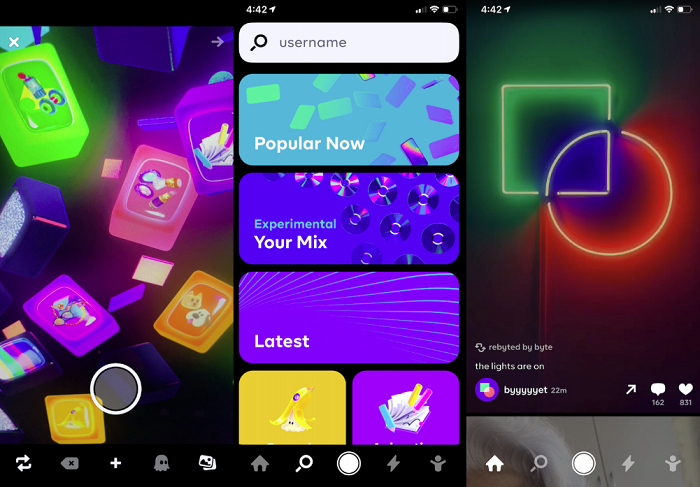SOCIAL
Byte, the Second-Coming of Vine, is Now Available on iOS and Android

After first announcing that he was working on a successor to Vine back in 2017, Dom Hoffman, the co-founder of the former short-form video leader, has now officially launched Byte, which is essentially the second coming of Vine, with updated features and focus.

As explained by Byte:
“We’re bringing back 6-second looping videos and the community that loved them. You know the drill: Upload from your camera roll or use the byte camera to capture stuff. Stay under the time limit and get lost in the loop. Explore what’s loved by the community, handpicked by our human editors, or just served up at random. There are lots of ways to discover surprising new personalities, voices, and moments.”
Functionally, Byte is very much like Vine, which, by extension, means that it’s also similar to TikTok, though as noted by TechCrunch, Byte, at launch, lacks any of the additional remix, AR and effects tools available on the rising video app. TikTok also allows for longer uploads, which could give it an edge – although Vine’s 6-second time limit definitely worked in its favor first time around. Perhaps it’ll catch on again, and make Byte the next big hit.
But then again, the reason for Vine’s eventual demise wasn’t a lack of popularity, at least not initially. Even if Byte does catch on, the app will need to evolve from its predecessor in one key area: providing monetization opportunities for its top creators, thereby motivating them to keep posting to the app.
For all the criticism leveled at Twitter for Vine’s demise (Twitter purchased Vine in 2012, then shut it down in 2016), Vine was actually shut down due to declining usage. At peak, Vine was serving some 200 million monthly active users, but as the app continued to rise, its top creators started to question whether they should be investing time into the platform, given that they could make a lot more money for the same content elsewhere.
That lead to some of the more popular Vine stars shifting focus. King Bach and Logan Paul moved to YouTube, while others, like Amanda Cerny, started posting to Instagram, platforms that have now made each of them respectively millionaires for their efforts.
And as the big names shifted focus, Vine view counts plummeted. Then in 2016, according to reports, 20 of Vine’s top 50 creators met with the company to deliver an ultimatum of sorts.
As reported by Mic:
“If Vine would pay all of them $1.2 million each, roll out several product changes and open up a more direct line of communication, everyone in the room would agree to produce 12 pieces of monthly original content for the app, or three vines per week.”
Vine declined, and they all adandoned it, taking their millions of followers with them to greener pastures. And that was pretty much it for the app.
Twitter repeatedly sought to mend bridges with its creative community, and offered a range of new tools in an effort to keep them around, but usage of the app continued to slide. By the time Twitter added pre-roll ads to Vines in June 2016, then extended the time limit to 140 seconds for selected creators, it was all over. Most of the app’s dev team had moved on, the major stars were making big dollars elsewhere. In the end, it made little sense for Twitter to keep supporting the app.
Twitter was then framed as the bad guy by Vine co-founder Rus Yusupov, who tweeted this shortly after Twitter announced the closure of the app.
But the fact was that Vine had been superceded, by Instagram and Snapchat in the content stakes, and by Facebook and YouTube in regards to monetization. That’s not to say that Twitter is beyond criticism for the platform’s demise, but to single out Twitter for ‘failing’ the app largely ignores the key factor – monetizing short-form video content is hard, and no platform has got it right yet.
Of course, nobody knows this better than Hoffman, who, from the get-go, has said that Byte will invest in its creators, and ensure that they get paid, even if it has to dip into its own funding to make it happen.
That’s an admirable commitment, but it does seem like a significant risk – particularly when you also consider that TikTok, for all its hype, still hasn’t worked out how it will facilitate monetization for its top stars.
That’s the key egg they need to crack – short-form video is engaging, and has repeatedly proven popular. But long-form video enables greater revenue generation. Snapchat struggled for a long time to work out its monetization options for creators, while Instagram added IGTV as a means to potentially supplement its main feed, and compete with YouTube. But when creators get to a certain popularity level, and they look across and see others doing similar work to theirs on other platforms, for a lot more money, things get complicated real quick.
That’s one of several ongoing concerns for TikTok (which, it’s worth noting, is also experimenting with longer videos to better facilitate monetization), and until Byte’s creator compensation program is fleshed out, it’ll remain a lingering concern for that app also.
Still, Byte looks engaging, and seems set to get at least some early hype. Whether that will be enough to drag users away from TikTok, it’s its first big challenge to overcome, then we’ll see how the next phase pans out.
You can download Byte now on both iOS and Android.
